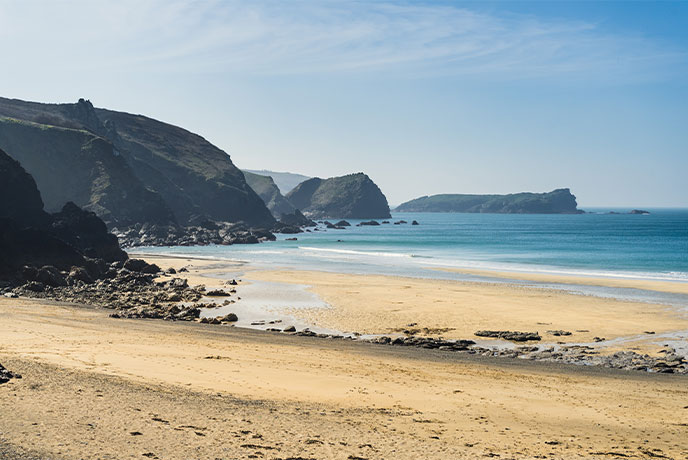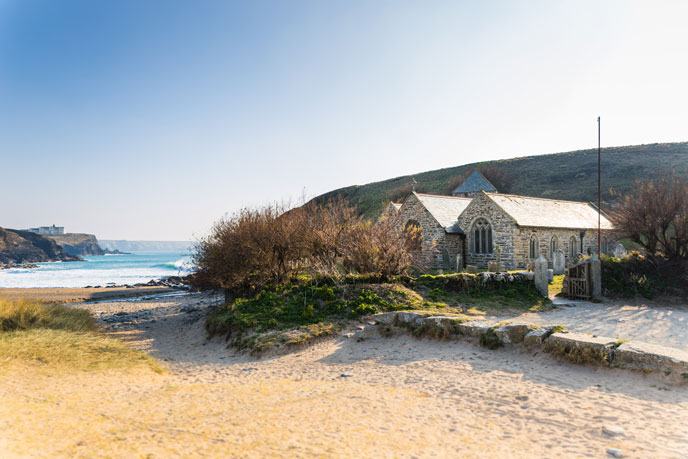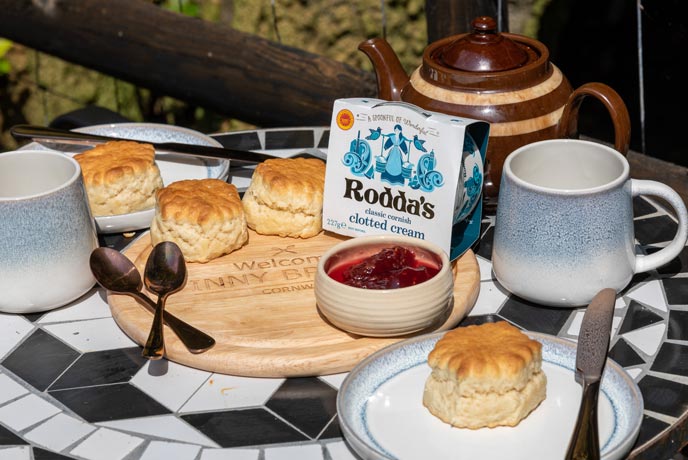The good old traditional village pub is at the heart of every community - physically, socially, and historically. For centuries they have been the places where events happen and where events are gossiped about! They are where we come together to eat, drink, and be merry, spend time with family and friends, relax, or celebrate momentous occasions.
Cornwall is bursting with hundreds of fascinating pubs, each with their own unique story to tell, from haunted haunts to smuggling favourites.
Whether you’re looking for a dog-friendly pub with an intriguing backstory or a welcoming spot to put your feet up in front of the fire, our guide to some of the most historic inns in Cornwall has everything you need for your next memorable pitstop.
The Turks Head, Penzance
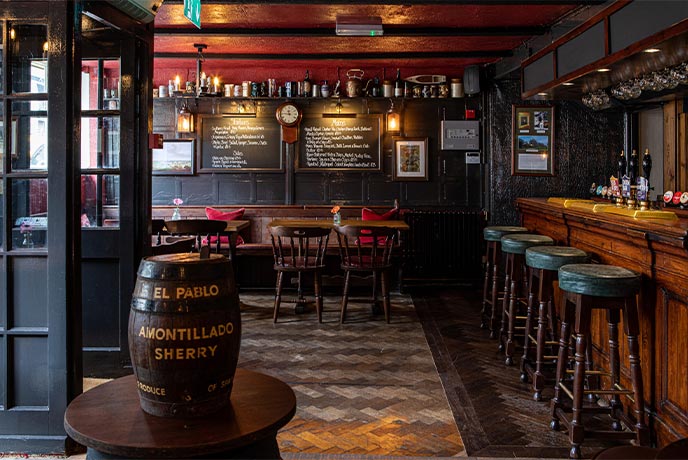
Local tradition has it that The Turks Head in Chapel Street in Penzance is the oldest inn in this historic town, if not the oldest in the whole of Cornwall. Its name dates back to at least 1233, when legend has it the harbour was invaded by Turks from the Holy Land. The 13th century was the time of the crusades to Jerusalem and names such as Turk’s Head or Saracen’s Head became popular for public houses across England.
In later years, this pub was said to be the notorious haunt of pirates and smugglers and the entrance of a tunnel leading from its courtyard to the harbour, which was used for such clandestine activities, can still be seen to this day.
The pub, which offers great food and drink in cosy surroundings, has embraced its amazing past and has retained as many original features as possible, with an olde-world style bar, quaint and comfortable snugs, and traditional low-beamed ceilings.
The Bucket of Blood, Phillack
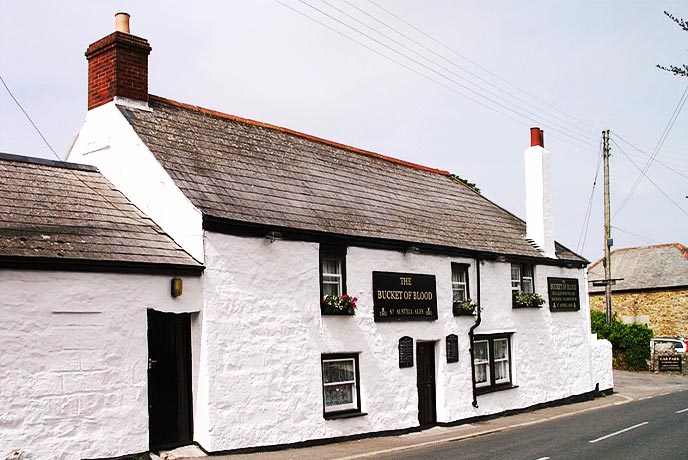
This has to be one of the best pub names in Britain! And of course there is a fittingly gruesome story behind the name.
The Bucket of Blood dates back to the late 13th century and there are a few stories to explain the origin of the inn’s unusual name. Folklore has it that a former landlord who pulled up a bucket from his well expecting water found it full of blood. On investigation, it was said that the well contained the corpse of a local smuggler. It is little wonder that the inn gained such a reputation for ghosts and paranormal activity!
However, at the risk of spoiling a good story, the name may have a less exciting explanation. It is more likely that the pub’s well contained water that had been made red by run-off from the local tin mining activity – the river nearby was known locally as the Red River. But if you feel like a little investigation into the story, you can still find the well just a stone’s throw from The Bucket of Blood!
Today the characterful pub, not far from the sands of Gwithian beach and the wonderful Godrevy lighthouse, serves up hearty dishes and has a lovely sun terrace to enjoy a lazy pint while you keep your eyes peeled for one of the resident ghosts.
Lamorna Wink, Lamorna Cove
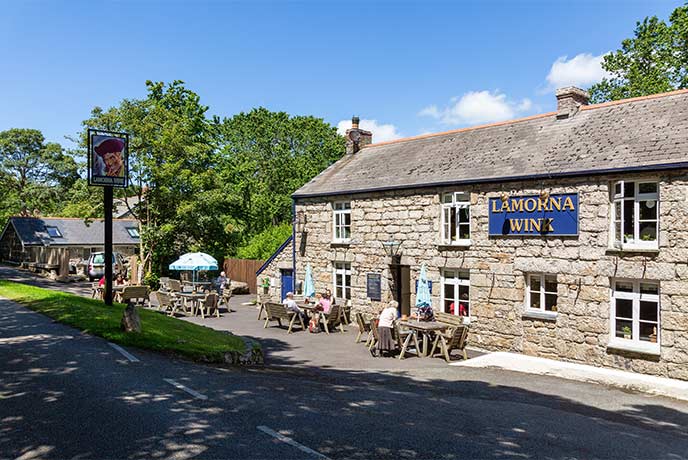
Just above the picturesque Lamorna Cove in the far west of Cornwall, a place that has long been a favourite with artists and writers, is the Lamorna Wink, at one time known simply as The Wink.
This pub’s name may derive from the old Cornish word ‘Kiddlywink’, which meant a simple beer house that was only licensed to sell ale, but it is also possible that the name has smuggling connections. It was said that local smugglers would ‘tip the wink’ to a landlord if they had contraband spirits to sell or customers could give the same signal if they wanted to purchase some of the illegal goods that might have hidden on a lower shelf.
The Lamorna Wink is a family-run inn with lots of charm and just a short walk from some of the finest coastal scenery in West Cornwall.
The Ship Inn, Porthleven

The fishing port of Porthleven has grown in popularity in recent years with lots of amazing eateries springing up around the beautiful harbour, with one delightful old pub standing sentinel above them all. Guarding the entrance to the harbour with stunning views across the bay beyond, The Ship Inn has been the retreat of many a Cornish fisherman since at least the 17th century.
If the views from the tiered pub garden aren’t enough, this wonderful inn is full of character inside as well as out. The walls and ceilings are covered in old beer mats and brasses, there are open fires to warm the cockles, and local ales to sustain you. Like so many of these seaside inns, The Ship was once frequented by smugglers and also has one or two ghosts lurking in the cellar.
So find yourself a comfy seat by the window and watch the waves crash against the harbour walls - The Ship is particularly fun during a storm!
The Halzephron Inn, Gunwalloe
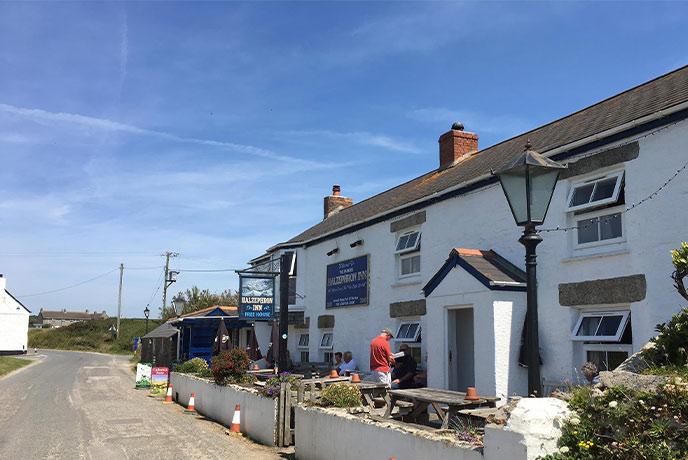
This is another old Cornish inn with intriguing smuggling connections! The Halzephron Inn, originally built in 1468, stands high on the cliffs above Gunwalloe and was known as the Ship Inn for many years. During the golden years of smuggling, it is said that many of its landlords were involved in ‘free-trading’.
Famously, the wall between the lounge and the Fisherman’s Bar is over 8ft-thick and contains a shaft that is said to have once given access to a tunnel that connected the inn to the coast.
One 19th-century landlord, Henry Cuttance, although a well-known smuggler, was also something of a shipwreck hero, saving dozens of lives from several different wrecks and receiving awards for his bravery, including a silver cup from the King of Norway.
Halzephron may mean ‘Hell’s cliff’ in Cornish but this pub is perfectly placed for grabbing some refreshments while exploring some of the most stunning stretches of the coastal path.
The Blue Anchor, Helston
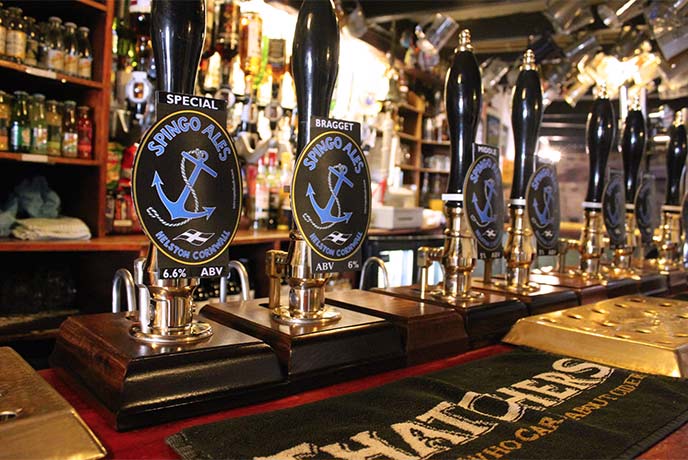
It is thought that beer has been brewed on these premises in Helston for more than 600 years, with the tradition started by monks who ran a rest house here from around the 13th century. When the monasteries were dissolved, the building became a tavern and in the 18th century the pub was popular with local tin miners who bizarrely had to come to the bar to receive their weekly wages.
At the rear of this picturesque thatched inn is a rare skittle alley, which dates back to the early 19th century. The pub itself has low beamed ceilings, an open fire, and is divided into several cosy rooms, each adorned with vintage posters and historical mementos. The world famous Spingo ale, which is still brewed on the premises and comes in three strengths – Middle, Best, and Special (which is 6.6%) – makes the Blue Anchor one of only four original brew pubs left in the whole of the UK and Cornwall’s oldest brewery!
Live music is a feature of evenings in the Blue Anchor, when the customers bring their own instruments and break into song after a few drinks!
The Pandora Inn, Mylor
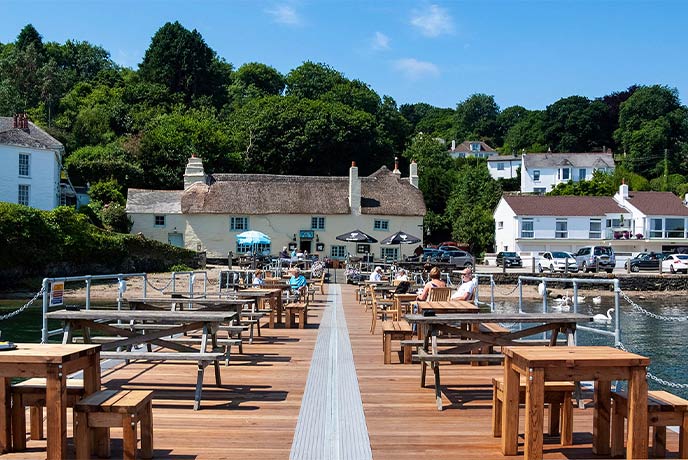
The Pandora stands close to the water’s edge on Restronguet Creek, a quiet branch of the River Fal. Parts of this ancient thatched building date back to 1250, making it one of the oldest pubs in England. Steeped in history, it has low ceilings, flagstone floors, and boating memorabilia covering the walls, including a wonderful figurehead of Pandora herself, complete with her infamous box!
Known as the Passage Inn for many years, the pub was renamed the Pandora Inn in the 19th century to honour HMS Pandora, the ship sent to search for the mutineers from the Bounty.
Today the inn focuses on fresh local produce that you can enjoy in the cosy surroundings of the 13th building or bobbing about on the floating decking on the creek outside! With lots of lovely trails looping around the creek, The Pandora is a firm favourite when it comes to a hearty walk with a pub at the end, especially on Sundays when their button-popping roasts are on the menu.
The Ferryboat Inn & Shipwrights Arms, The Helford

These two historic pubs face each other across the waters of the Helford River. Connected by a small passenger ferry, which is thought to have been running in one form or another for the last 900 years, it’s fun to cross the river and partake in a mini pub crawl between the two, all while enjoying the stunning scenery.
This stretch of The Helford was a hang out for pirates and smugglers, most notably the infamous Carter brothers of Prussia Cove, who visited here regularly and were involved in skirmishes with the Revenue men on the river on several occasions. A wonderful scene to imagine as you sip your drink! You can also visit nearby Frenchman’s Creek, which was made famous by Daphne du Maurier’s tale of romance and French pirates.
This is a great destination for those who enjoy watersports too, as kayaks and motorboats can be hired from outside the Ferryboat Inn, and the Shipwrights Arms has its own quay, so you can access the pub straight from the water.
The Norway Inn, Perranarworthal

This inn stands beside the road between Truro and Falmouth and its history harks back to the time when this whole area was a hive of industrial activity. The nearby Perran Foundry once produced mining machinery that was used in mines across the globe, from Australia to Argentina, and ships from far flung destinations would arrive at the now silted-up quays.
The Norway, which has been a pub since at least the early 19th century, gets its name from the Norwegian barges that would dock at the wharfs here loaded with timber to make pit props for our Cornish mines.
If you like the sound of this fascinating area you can also stay in one of our most unique properties right across from the pub. The beautiful wooden barge, Mistery 2, rests in a tidal creek at Perranarworthal and makes a relaxing getaway as the tide ebbs and flows beside you.
The Jamaica Inn, Bodmin Moor
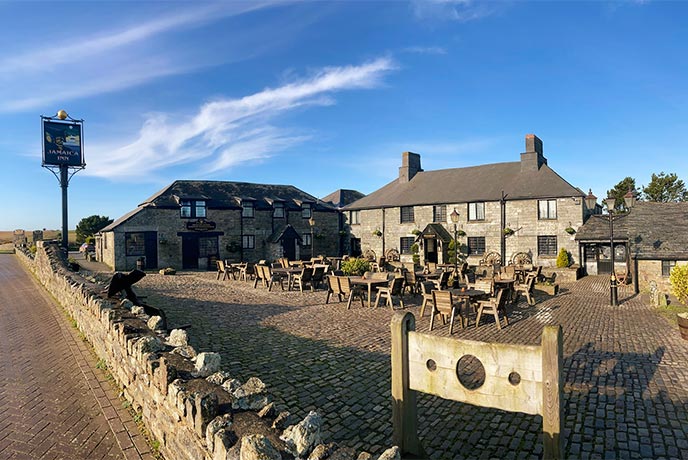
Another place to be made famous by the work of Cornwall’s best-loved writer Daphne du Maurier, The Jamaica Inn sits nestled in the wilds of Bodmin Moor, making it a wonderful place to visit.
It was built in around 1750 as a coaching inn for weary travellers making the tough journey across the moors. Du Maurier visited the inn as a young woman when she and a friend became lost in fog while riding over the moors. They were led back to the safety of the pub by their horses and, while recovering from her ordeal, the local rector is said to have entertained the writer with ghost stories and tales of smuggling! The novel Jamaica Inn followed in 1930.
As well as still offering comforting food to travellers, the pub also has its own museum, which explores the history of this extraordinary landscape and the tales of the smugglers and ne'er-do-wells that once roamed these untamed moors.
The Cobweb Inn, Boscastle
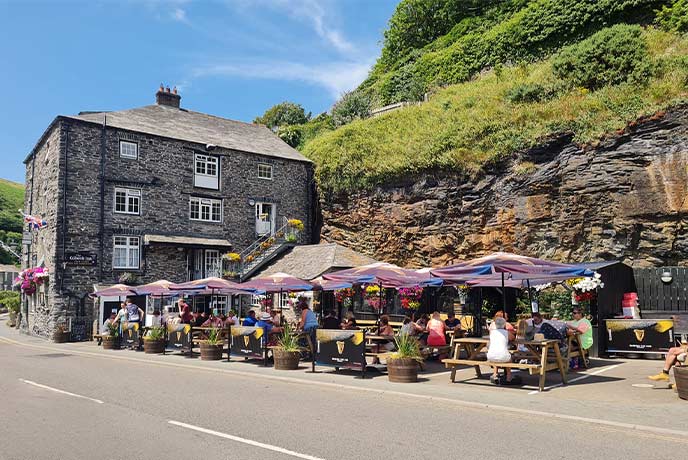
Originally used as a kind of ad-hoc off licence in the early 18th century, The Cobweb Inn, as it came to be known, was once one of 22 pubs in the little harbour of Boscastle.
In 1947, the ground floor was turned into a public bar and became the ‘Cobweb’ because of the copious webs that hung from the ceiling in a thick mat. Though they would have been considered rather unhygienic today, the spiders had actually been encouraged by merchants to keep the flies away from the kegs of alcohol!
Swapping cobwebs for a quaint pub atmosphere with live music every week and delicious food, this cosy inn is the perfect pitstop when walking the surrounding coast paths. Not to mention Boscastle, with its Witchcraft Museum, makes a quirky place to visit on this beautiful stretch of North Cornwall.
The Tree Inn, Stratton

This historic, character-filled inn not far from the seaside town of Bude started life in the 13th century as a manor house, and it’s fair to say that there is hardly a straight wall or a level floor in the building - walking along the upstairs corridor feels like you are walking on board a ship!
It was once the home of the real Cornish giant, Anthony Payne, who was bodyguard to Sir Beville Grenville during the Civil War. Payne was over 7ft tall and his home, now the Tree Inn, was used to house Parliamentarian prisoners after the Battle of Stratton in 1643.
The beams in the ceiling of the restaurant are said to be timbers salvaged from shipwrecks on the coast, including a Spanish galleon.
Today, this inn is a welcoming place offering log fires and an array of gins and whiskeys as well as hearty meals.
The Three Pilchards, Polperro
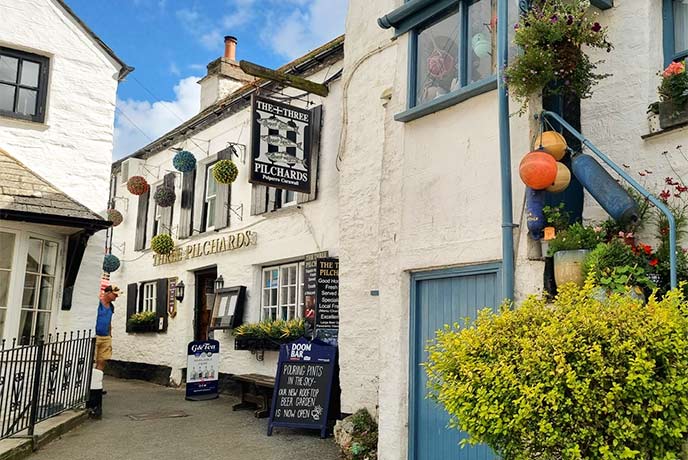
The oldest pub in the picturesque fishing harbour of Polperro, The Three Pilchards is situated right in the heart of the village close to the quay.
Built around 400 years ago in the 16th century, the inn’s name derives from the three pilchard factories that once stood in the village. As well as fishing, smuggling was very much part of Polperro’s history.
One of the landlords at The Three Pilchards’ in the 19th century, Charles Jolliff, was rumoured to have sold contraband liquor over the bar. Local legend had it that if the locals saw his mare saddled outside, then it was a signal that he had a new shipment of smuggled goods available to purchase such as tea, gin, brandy and tobacco brought across from the Channel Islands.
The Three Pilchards remains a wonderful place to sit back, relax, and enjoy the delightful surroundings while pondering on the escapades of the customers of the past.
Whether you are looking for a coastal retreat or a cosy cottage with a flickering fire, our holiday cottages across Cornwall have you well and truly covered, promising many adventures at one of Cornwall’s nearby historic inns - some even have a pub next door!


